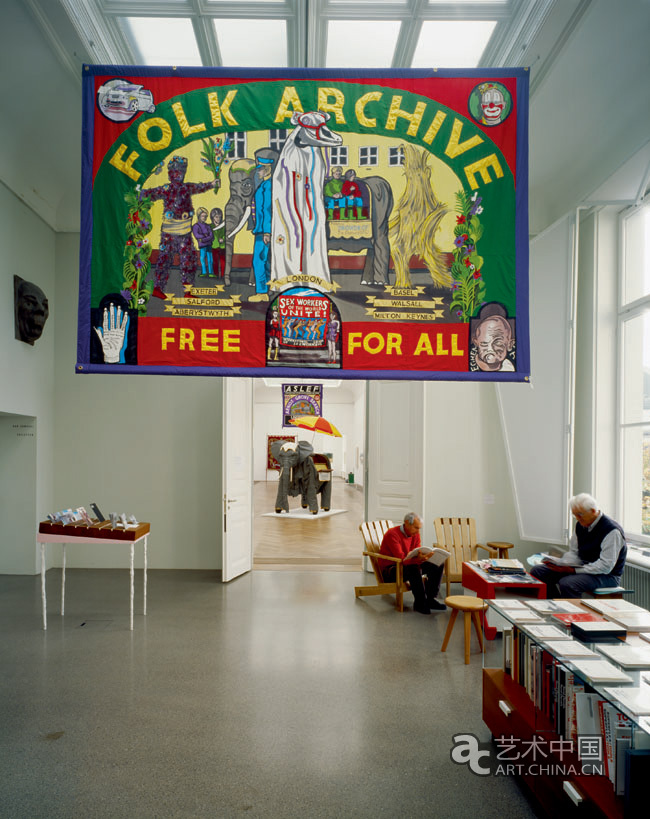傑裏米戴勒和艾倫凱恩的《民間檔案》 |
| 藝術中國 | 時間: 2010-01-29 18:37:45 | 文章來源: 藝術中國 |
|
傑裏米戴勒和艾倫凱恩的《民間檔案》 Jeremy Deller and Alan Kane Folk Archive 2005 Mixed media Dimensions variable 傑裏米.戴勒和艾倫.凱恩 民間檔案,2005 可變尺寸
傑裏米•戴勒和艾倫•凱恩知道自己創作的《民間檔案》跨越了一條微妙的邊界。他們對二十世紀末和二十一世紀初英國當代流行藝術作品的收藏和分類處於藝術和人類學之間的寬闊邊界地帶,而且這兩位藝術家知道他們冒著偏離主題的風險。正如他們從一開始就承認的:“對於那些喜歡人類學方法的人們,我們必須道歉,因為我們知道‘檔案’這個詞使用在這兒未免有失偏頗,同時我們對細節的處理也充滿著藝術的隨意。對於從事民間或地方文化研究的人們,我們也要道歉,因為我們的‘民間’內容十分粗淺,對這些領域的粗略縱覽也缺乏可靠的依據。”①但是,正是由於這兩方面細微的背離之處,我們才能看到戴勒和凱恩希望借助《民間檔案》傳達的主題:在神聖藝術世界的雷達下跳動著噴發創造性的廣大的公眾之心。 這個檔案包括從古至今英國各地的節日慶典的紀念品、往往被人忽視的咖啡館主、漢堡包售賣車車主和小店店主的行動、以及更具有政治意義的抗議者和監獄犯人的活動。每件作品都是人們為了傳遞資訊情感而發,無論是愛、悲傷、憤怒或一杯好茶。例如,坎伯蘭和威斯特摩蘭郡精美的男性摔跤服,有著手工刺繡的雅致捲曲花葉圖案,經常被評論家挑選出來作為民俗文化的特別代表。在坎布裏亞納的埃格蒙特克拉布嘉年華活動中,男人們穿著這種裝飾精美的服裝參加摔跤比賽,這個節日從1387年開始,包括一系列令人眼花繚亂的盛裝遊行和比賽活動。湯姆•莫頓描述道:“這種包裹著華麗雄蕊和花瓣圖案類似勞倫斯重構的男性形象也許不能在全國範圍內流行(電視上的硬漢不會穿著玫瑰圖案的短褲死去),但是對這個小地方的摔跤愛好者來説,這卻似乎完全説得通。”② 同時,在這個檔案中,除了長期的(而且往往是鄉村的)傳統之外,也有主流的流行藝術。例如,其中收入了戴安娜王妃的紀念作品,還有一幅在謝菲爾德墻上的“辛普森一家”的畫,即使它與我們熟悉的卡通人物並不相像。觀者還會看到做成聖約翰救護車形狀的針墊、無上裝酒吧女郎倒啤酒的水彩鉛筆畫、插花、定制的摩托頭盔和生日資訊等。 然而,觀者會不止一次地在這些作品之間發現:其中隱含著收藏和展出它們的藝術家的嘲諷或竊笑。《民間檔案》一個值得爭辯的基礎是一種理解,認為“現在,這個無心世界的心臟是流行文化,而不是宗教。”③ 在這裡,愛的行為從盛大輝煌到平凡瑣屑,無所不在,無法用當代藝術的冷眼去旁觀。正如戴勒所説:“沃霍爾説流行藝術就是關於喜歡事物,而對於我來説,民間藝術則是熱愛事物。”④ 雖然《民間檔案》中也收入了政治旗幟和藝術作品,但是其中最具政治意義的可能是它揭示的一種對普通大眾的基本而制度化的不信任,以及進一步揭示了這種不信任的缺乏根據。在這個檔案中,觀者很容易看出,普通大眾並不是被動地盲目前行的一群過客,而是積極主動有個性的個人,他們是在不斷創造、製造、改變和組織的人們。戴勒和凱恩雖然公開地背離了主題,但實際上卻展示了一種內在深刻、長期存在的革命性力量。 ①傑裏米•戴勒和艾倫•凱恩,《民間檔案:英國當代流行藝術》,(倫敦,Book Works,2005) ②湯姆•莫頓,“民間檔案”,Frieze雜誌,93(2005年9月),134 ③大衛•比奇,“一堆好屎:關於流行文化的倫理關係”,選自傑裏米•戴勒《生活是責備一切:1992-99作品項目集》,(倫敦:Salon 3,2001),94 ④戴勒被塔妮婭•布蘭尼根在“概述”中引用《衛報》(2004年11月3日),13 Alan Kane and Jeremy Deller Jeremy Deller and Alan Kane know that they tread a delicate line with the Folk Archive. Their collection and documentation of contemporary popular art in the UK at the turn of the century is situated in the rich seam between art and anthropology – and the artists knew they ran the risk of exploiting their subjects. As they conceded from the start, ‘For those interested in an anthropological approach, we must apologise for the rather too knowing misuse of the phrase “archive” and an artistic casualness with details. For all involved in the folk or vernacular cultural scenes we must similarly apologise for the cheap “folk” shot and a fly-by-night plundering of whole worlds.’ It is only through these two small betrayals, however, that we are able to see what Deller and Kane are getting at with Folk Archive, and that is: a large public heart beating out creativity under the radar of a sanctified art world. The archive contains relics from festivals and celebrations across Britain, ancient and modern, as well as the ignored efforts of owners of cafes, burger vans and shops, and the somewhat more politicised efforts from protesters and prison inmates. Each work is made by people who have, quite simply, created things to convey their message, be it love, sadness, rage, or a nice cup of tea. The beautifully hand-embroidered male wrestling costumes of Cumberland and Westmoreland, for example, with their curling images of dainty flowers and leaves, are often picked out by commentators as vernacular and culturally specific. The decorative costumes are worn by men taking part in wrestling matches as part of the Egremont Crab Fair in Cumbria, a festival established in 1387 and encompassing a bewildering array of parades and contests. As Tom Morton describes, ‘This D.H. Lawrence-like reframing of masculinity as something intertwined with the fecund stuff of stamens and petals wouldn’t play on a national stage (no TV hard man would be seen dead in rose-patterned briefs), but in this small community of wrestling enthusiasts it seems to make sense.’ As well as long-held (and often rural) traditions, however, proper pop is present too. Memorials to Princess Diana are included, as is a painting of ‘The Simpsons’ on a Sheffield wall, albeit bearing little resemblance to the familiar cartoon characters. Viewers might also stumble across a pincushion made in the shape of a St John’s Ambulance vehicle, a watercolour pencil drawing of a topless Page 3 stunner pulling a pint, flower arrangements, customised motorcycling helmets and birthday messages. Not once, however, will you find an underhand sneer or snigger from the artists who collected and presented this work. Arguably, what underpins Folk Archive is an understanding that ‘it is popular culture now, not religion, that is the heart of a heartless world’. The acts of love here range from the grand to the quotidian, impossible to view with the cool eye of contemporary art. As Deller comments, ‘Warhol said that pop art was about liking things, whereas for me folk art is about loving things.’ Though there are political banners and artworks here, perhaps the most politicised thing about Folk Archive is that it reveals a basic, institutionalised mistrust of the general public, which is, in turn, revealed to be unfounded. It is possible to discern here a general public that is not a passive, shuffling and pedestrian herd, but a mobilised set of individuals who create, make, change and organise. Deller and Kane, whilst openly betraying their subjects, reveal a potentially revolutionary, yet heartfelt, force that was there all along. L.M.F. |
| 注:凡註明 “藝術中國” 字樣的視頻、圖片或文字內容均屬於本網站專稿,如需轉載圖片請保留 “藝術中國” 浮水印,轉載文字內容請註明來源藝術中國,否則本網站將依據《資訊網路傳播權保護條例》維護網路智慧財産權。 |
